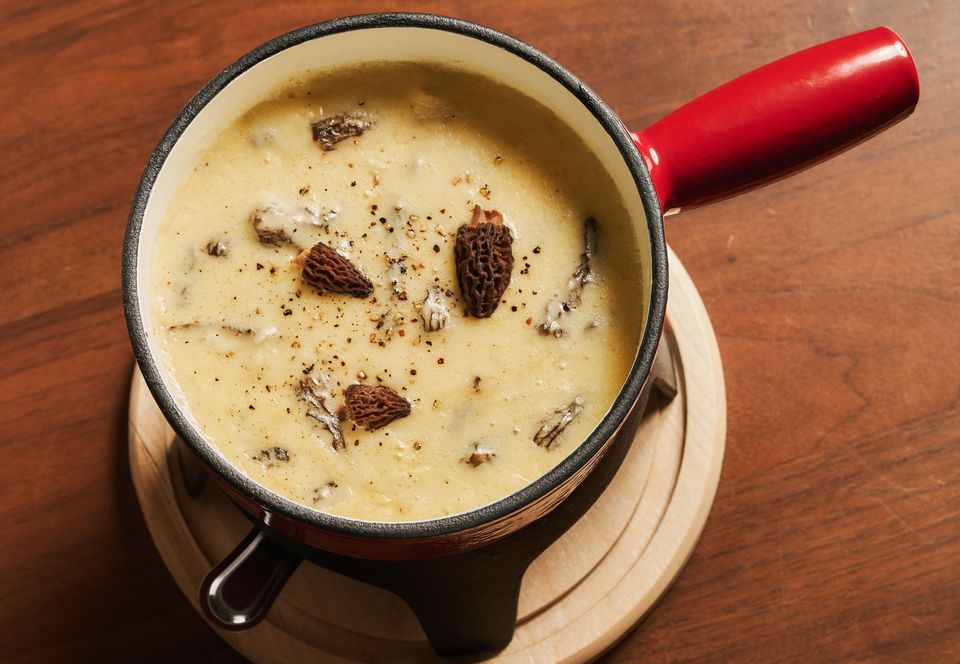After raclette, this is the other favorite dish of cheese lovers. Fondue has the advantage of being particularly convivial because it is shared in a pot which is placed in the middle of the table. The basic recipe is ultra-simple: cheese, white wine, and bread. But be careful, success depends on the choice of ingredients and dosages…
It is at the Babines station, four chalets installed for the winter in the courtyard of the Grand Quartier hotel (Paris 10th) that we went to get our information. Hugo des Jamonières, restaurateur at the helm of the Babines bistro who, with his partner Louis Bonjour and with chef Théophane Eymard (ex-Gare au Gorille), explains to 20 minutes what are the simple tips likely to make your fondue memorable.
1. The choice of cheeses
Are you more of a Savoyard team or a Swiss team? This is important because a fondue is the result of a mixture of several cheeses. Savoy cheeses in the Savoyard fondue, Swiss cheeses in the Swiss fondue, obviously.
In the Savoyard fondue recipe, you will have to use three cheeses in equal proportions. A priori, it is abundance (or Comté), Emmental and Beaufort, but you can vary this mixture as you wish. If you are hesitant, as we understand, ask your cheesemaker for advice, who knows his cheeses and will provide you with the best combination according to your tastes.
Switzerland also offers countless variations of fondues. The Fribourgeoise fondue contains only Vacherin Fribourgeoise while the Neuchâteloise fondue is made with Emmental and Swiss Gruyère. But the best known and most traditional Swiss fondue is the half-and-half fondue. As its name suggests, it is prepared with two cheeses in equal proportions: Vacherin Fribourgeois and Swiss Gruyère, the balance coming from the marriage of a softer cheese and another drier. It is this fondue that is served for 25 euros per person with a salad at Station Babines.
“It was my partner, who attended a hotel school in Lausanne, who convinced me,” says Hugo. It’s true that after having tested quite a few, the Swiss fondue is really creamier, smoother, more emulsified too, than the Savoyard fondue which is also very nice to eat, but which seemed heavier, less digestible to us. . Above all, from my point of view, Swiss tastes much better. »
2. Dare to use mushrooms
It’s very fashionable to offer, in addition to natural fondue, mushroom fondues. Babines Station has chosen the morel (for 30 euros per person).

“It’s a very good mushroom, very tasty, which gives the fondue a little smoky, forest taste, absolutely delicious,” says Hugo. We also tried the porcini mushroom, very pleasant when you come across a piece, but the rest of the preparation didn’t have much flavor. While the morel… We put it in just a minute before taking the fondue off the heat and putting it at the table, because you don’t necessarily have to cook the mushroom but just so that it can release its flavors in the fondue. » La Station Babines sometimes offers black truffle, grated in the fondue (for 38 euros). “It’s also very good, of course, provided you can obtain beautiful truffles at a reasonable price. Not easy. » So far, they have only been able to serve it a few evenings.
3. The dosage of quantities
As with raclette, we are in the presence of a dish that is both caloric and addictive, the quantities of which it is better to measure beforehand as we are capable of devouring it endlessly and even without hunger. Hugo recommends “220 g of cheese per person”. Large appetites will increase the dose slightly, but in moderation. Added to this is “6 cl of dry white wine from Savoie per person” (not to drink but to pour into the fondue pot, eh), a little cornstarch to bind the mixture and make it more homogeneous and a cap of kirsch to two people. No nutmeg at Babines Station, but you can grate a little at home, if you like it.
Anyone who likes garlic can also rub the bottom of the fondue pot with a clove before adding the cheese. Not at Babines Station. “We prefer to rub the loaves of bread with half a head of garlic before the meal and ask everyone if they prefer garlic bread or not. » While we’re on the subject of bread, it’s better to cut it and make it stale at home, in good pieces 4 or 5 cm thick. Hugo gets his supplies from Mamiche, a bakery known for its breads with a delicious sourdough taste. “To ensure it is well dried, we use the bread received the day before,” he explains.
4. Attention to detail
You can just eat the cheese on bread or rather bread in cheese, but it quickly gets a little boring. As with raclette, the choice of accompaniments is important. Small new potatoes cooked in the oven or steamed, a green salad as we have seen, and the least fatty cold meats possible. Here it is Graubünden meat, a “fairly dry” Ardèche rosette, Corsican coppa and a Prince de Paris white ham which brings a little freshness. You can replace the cold meats with a pan of mushrooms or oyster mushrooms at Station Babines. They don’t do it there, but you can also add onion or gherkin pickles for a welcome touch of acidity.
